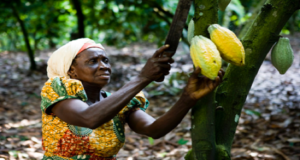
Cocoa is believed to have originated from Central America about 5,000 years ago, as it was a delicacy of the inhabitants along the Yucatán; but today, production of the cash crop has gained global recognition. With three main varieties – Forastero, Trinitario and Criollo – Forastero is the most widely-produced cocoa variety, comprising about 90% of the cocoa produced worldwide. Criollo is considered a delicacy, but compared to the Forastero it has low resistance to diseases and a lower yield.
The Trinitario is a hybrid of Criollo and Forastero – this variety is disease-resistant and has a higher yield compared to the Forastero. According to the Food and Agriculture Organisation Corporate Statistical Database (FAOSTAT) of the United Nations in 2017, Ivory Coast was the largest producer of cocoa with 2,034,000 tonnes, representing 38% – Ghana was second with 883,652 tonnes, representing 17%. Nigeria and Cameroon placed 4th and 5th, producing 328,263 tonnes and 295,028 tonnes respectively.
The economies of these African countries have benefitted immensely from the production and exportation of cocoa. In 2017, Ivory Coast recorded a trade surplus of US$1.96billion after exporting US$10.3billion and importing US$8.37billion worth of goods. With a population of 24.29 million in 2017 according to the World Bank, agriculture and its related activities have been the primary occupation for two-thirds of the population. The Gross Domestic Product (GDP) of Cote d’Ivoire in 2017 was US$37.4billion – cocoa bean was the top export, generating US$3.79billion; rubber, cocoa paste and cocoa butter generated US$1.1billion, US$1.04billion and US$624million respectively.
The economic narrative for Ghana in the last decade also relays economic thriving – the economy of Ghana averaged a growth rate of 6.68% from 2000 to 2018, with 25% being the all-time high recorded in the first quarter of 2012 and -1.6% being the lowest; recorded in the third quarter of 2015.
In 2017, Ghana exported US$17.1billion worth of goods and conversely imported US$13.2billion – recording a balance of trade of US$3.9billion and a GDP of US$59billion. Cocoa beans and cocoa paste rank 3rd and 4th on the 2017 list of top exports from Ghana – contributing US$1.77billion and US$538million respectively. With a population of 28.83 million in 2017, about 52% of Ghana’s labour force was engaged in Agriculture. The cocoa sector accounts for about 800,000 jobs across six regions in Ghana.

Source: International Cocoa Organisation (ICCO), 2019
The above chart displays annual average price of cocoa per kilogramme between 2009-2019. In recent times the commodity market has been bearish for cocoa, especially through 2017 when the cash crop only increased once in the last quarter – but the price fell once more to end the year at US$1,917.68 per tonne. More than two-thirds of the cocoa price has been wiped-off following a sharp decline in the price of cocoa, which began in 2016.
The price for a tonne of cocoa has decreased from US$3,000 to a little over US$1,900 in a space of two years even though there has been a significant rise in the production of the cash crop within this duration. This development has affected the economic activities of cocoa farmers, since their income has decreased by 30-40 percent as recorded by the Cocoa barometer in 2018.
The decline in price of cocoa has not only been a major problem for cocoa farmers – the economies of Ivory Coast and Ghana, the two largest producers and exporters of cocoa, have experienced negative effects from the drop in price of the cash crop; with the International Monetary Fund (IMF) cautioning the latter to reduce its domestic price of cocoa to reflect the price of cocoa on the international market. COCOBOD, the institution that controls the buying price of cocoa in Ghana, is currently grappling with a financing gap of GH¢1billion – an equivalent of 0.3% of GDP.
In 2015, the commodity market for cocoa was bullish as reported by the International Cocoa Organisation (ICCO) – the increasing demand from the new markets, specifically China and India, resulted in the boom that motivated cocoa farmers to produce a surplus of 400,000 tonnes against the annual 4 million tonnes supply.
The cocoa farmers overproduced out of expectations from the bullish market for the cash crop at the time. In the first quarter of 2018, the presidents of Ghana and Cote d’Ivoire signed the ‘Abidjan Declaration’ – an agreement that reaffirms the two largest cocoa producing and exporting countries’ commitment to address challenges plaguing the cocoa sector of both countries.
In June 2019, representatives from Ghana and Cote d’Ivoire with other participants in the cocoa industry met to work out new modalities against the ‘Take it or Leave it’ modus operandi for pricing cocoa on the global market. The inclusion of Nigeria and Cameroon in the current arrangement can result in a solid resolution of the deteriorating situation in the cocoa industry, as these countries are ranked in the top-five cocoa producing countries of the world.
Cocoa was Nigeria’s 4th top export, generating US$660million and a GDP of US$375billion in 2017 – Nigeria is Africa’s largest consumer market, controlling about 15% of the overall growth by 2025 as reported by McKinsey Global Institute (MGI), the business and research arm of McKinsey. Cocoa is the 3rd top export of Cameroon, generating revenue of US$492million to a GDP of US$34.9billion in 2017. Cameroon and Nigeria are also experiencing the negative impacts from the huge drop in price for cocoa on the global market.
In 2016, Fortune Magazine published a study that showed about 2.1 million children in the cocoa producing countries of West-Africa are engaged in harvesting cocoa – government agencies have paid lip-service when it comes to eradicating child-labour in Africa. In April 2018, the cocoa barometer published a report about the US$100billion cocoa industry – the cocoa barometer declared this about child-labour: “Not a single company or government is anywhere near reaching the sector-wide objective of elimination of child-labour – and not even near their commitment to a 70% reduction of child labour by 2020”.
Another prevailing challenge for the cocoa sector in Africa is the lack of adequate processing plants that could convert the raw cocoa beans into world-class finished products. For many decades, cocoa has been exported from Africa in its raw form. On the other hand, Europe is a well-known location for consumption of cocoa products – the European market accounts for about 50% of global retail sales for chocolate.
In 2017, the European cocoa-processing industry experienced an increase of 1.3 million tonnes, representing 2.6% and exported US$20.6billion of chocolate products – the market accounted for about 74% of global sales for chocolate, as published by the CBI- Centre for the Promotion of Imports from developing countries. During this period, cocoa-producing countries in Africa were experiencing the negative impacts of the huge drop in price for cocoa on the commodity market on their economies as a result of the surplus on the market – a clear indication that cocoa producing countries in Africa should rather invest in processing cocoa into finished goods if they are to make the most out of the cash crop.
About the Authors
Alexander Ayertey Odonkor is a chartered financial analyst and a chartered economist specialised in the economic landscape of developing economies. Alexander holds a Master’s degree in finance and a Bachelor’s degree in economics and finance.
Emmanuel Amoah-Darkwah is a chartered economist with specialisation in economic policy analysis, and an ambassador for the United Nations’ Sustainable Development Goals. Emmanuel’s work has been covered by the BBC, Bloomberg, CGTN, CNBC Africa and other major domestic news outlays in Africa.










